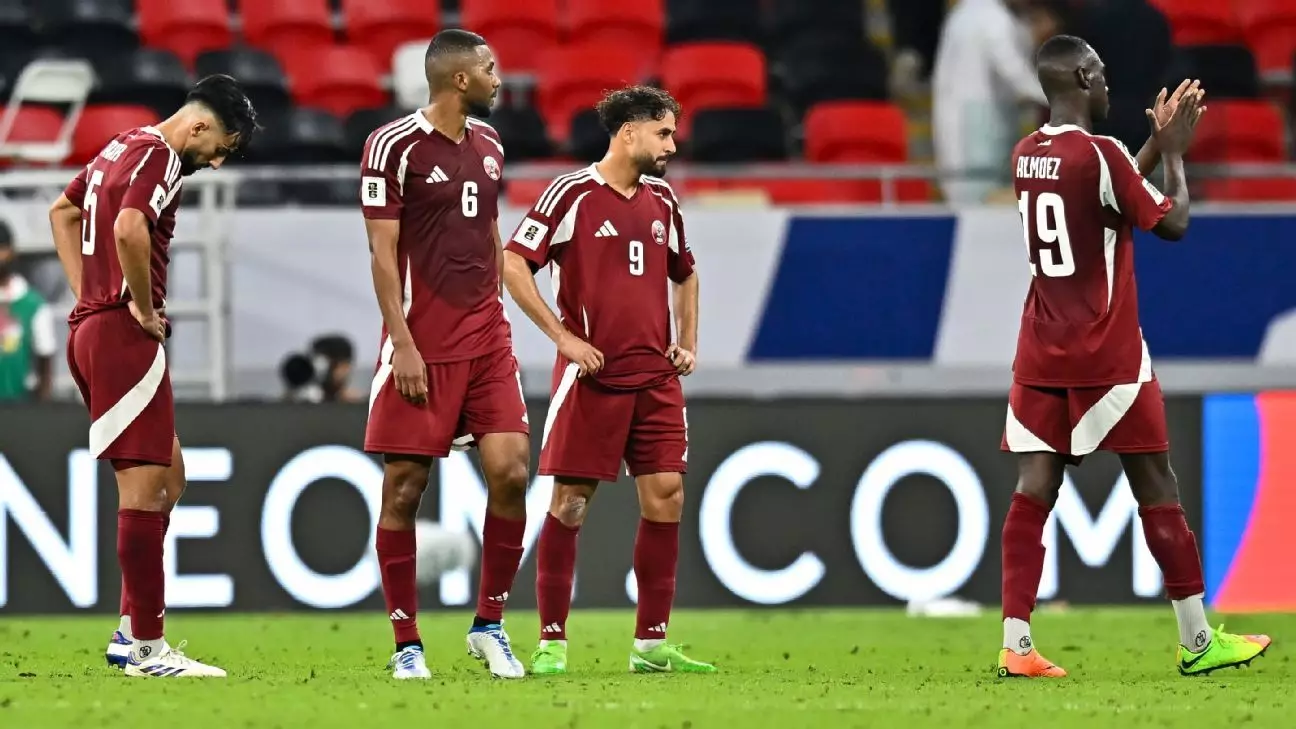Qatar made headlines in 2022 by hosting their first FIFA World Cup, dazzling fans and critics alike with their modern facilities and rich cultural experiences. The nation aimed to solidify their presence on the global football stage by qualifying for the 2026 tournament through merit rather than as hosts. With a significant expansion to 48 teams and eight guaranteed spots for Asian Football Confederation (AFC) teams, optimism ran high for the Qatari squad. However, the rollercoaster ride of the Asian qualifying rounds has thrown these aspirations into jeopardy.
Fast forward to the ongoing qualifiers, and Qatar finds itself in a precarious fourth position in Group A. With only two victories out of six matches, the statistics paint a grim picture for the reigning AFC champions. A paltry seven points and a daunting tally of 17 goals conceded highlight serious defensive frailties — the worst of all 18 teams competing in the qualifiers. The recent humiliating defeat to the United Arab Emirates, losing 5-0, exposed the team’s vulnerabilities on a grand scale, leaving fans and analysts questioning the trajectory of Qatari football.
Typically, teams that have tasted continental glory should exhibit resilience and consistency, but Qatar’s recent form suggests otherwise. With historical rivals like Iran and up-and-coming teams such as Uzbekistan and the UAE showing strong performances, Qatar initially appeared to have the edge over these teams. Instead, a lack of cohesiveness and defensive coordination has plagued the squad.
Manager Tintín Márquez faces intense scrutiny as questionable tactics further muddle the team’s game plan. The experimentation with various formations (from a 5-3-2 to 4-4-2) has not yielded the desired results. The absence of a stable playing style may hinder the team’s ability to capitalize on its talent. The on-field dynamics have also been affected by the fluctuating roles of key players, leaving them out of place and lacking the synergy necessary for success.
Examining the Squad Dynamics
Despite the alarming statistics, it would be overly simplistic to attribute Qatar’s struggles solely to managerial tactics. A deeper inquiry reveals a shift in player dynamics and leadership roles within the squad. The core players who led Qatar to their Asian Cup victories, such as Akram Afif and Almoez Ali, are still part of the team but may be burdened by expectations. The team also features a nuanced mix of young players such as Meshaal Barsham and the emerging talent of 19-year-old Ibrahim Al-Hassan, who presents potential, albeit in a less prestigious environment than his predecessors.
Older icons like Boualem Khoukhi and Abdulaziz Hatem, while experienced, cannot shoulder the responsibility of transition indefinitely. As a new generation begins to assert itself, the transformation inherent in phasing out older players sometimes results in growing pains. The question arises: are they receiving enough support to flourish in their new roles, particularly with the monumental expectations placed on them?
Moreover, the leadership landscape within the squad is undergoing significant changes. Al-Haydos, a former captain, commanded respect both on and off the pitch. Now that Afif has stepped up to lead the team, players may be looking for different sources of inspiration. While Afif is undeniably talented, he embodies a more understated leadership style, thriving on his individual skills rather than assuming command vocally.
This leadership transition may exacerbate internal pressures as new player hierarchies emerge. The lack of a steadfast guiding voice amidst tactical uncertainties creates an environment of instability that might be hard to overcome in high-stakes qualifiers. Alongside the retirement of veteran players, the team is undergoing a total makeover just before the critical juncture of the qualifiers.
Looking Ahead: A Roadmap to Recovery
As the remaining matches loom, Qatar must rethink their strategy. A focus on refining defensive structures and establishing a consistent tactical identity is imperative. Building a solid framework allows for individual brilliance to shine, creating an ecosystem where players can seamlessly integrate their skills into the larger team vision.
Sustaining a competitive edge requires leveraging their rich pool of talent while ensuring that inexperienced players are given the necessary guidance to flourish. Tapping into the experiences of former stars and infusing them into the current squad may also provide vital insights for overcoming any obstacles they encounter.
In closing, Qatar’s current landscape is laden with challenges that must be addressed to restore their status as a formidable force in Asian football. With World Cup qualification hanging in the balance, the quest for improvement must take precedence as they seek to reclaim their winning form and fulfill the dreams of an ambitious nation.

